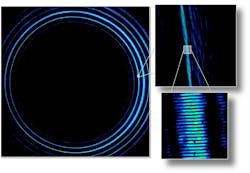Quantum Optics: Light with extremely high orbital angular momentum has exquisitely fine structure
If light is given a twisted phase via a suitable optical element, it acquires orbital angular momentum (OAM). The higher the OAM of a photon, the more information it can carry—as a result, OAM is a hot topic now in leading-edge optical communications and quantum optics experiments. For example, data rates of up to 100 Tbit/s have already been achieved under laboratory conditions. Optics that produce OAM include refractive, holographic, or other refractive, reflective, or spatial light modulators (SLMs).
The OAM quantum number in a helical beam can be quantified by the number of angular 2π phase shifts the optics supply to the beam. The higher this number, the higher the beam's OAM, and the higher the number of individual mode-like features appear in the beam.
Now, researchers from the University of Vienna (Vienna, Austria) and Australian National University (Canberra, Australia) have created beams with an OAM quantum number of 10,010, resulting in strange multiringed beam profiles with exquisite detail in the rings (as one can see in the multiple zoom-ins in the figure at the very top).1 This structure is inherent in the individual photons in the beam, as each photon in the beam has an OAM of 10,010ℏ (where ℏ is the reduced Planck constant).
The researchers wanted to determine whether quantum physics still held in the limit of large quantum numbers, or whether classical physics and everyday experience took over. For this purpose, the researchers took advantage of a technique developed by the colleagues in Australia. There, they fabricated spiral phase mirrors to twist photons in an unprecedentedly strong manner, thus increasing the quantum numbers to huge values. The mirrors, custom-made for the experiment in Vienna, allow the generation of OAM photons with huge quantum numbers a hundred times larger than in previous experiments.
Diamond-turned aluminum mirrors
Three different spiral-phase mirrors were fabricated. The 50.8-mm-diameter aluminum mirrors have a number of stepped angular segments that are machined into the metal using a precision single-point-diamond lathe, and in total produce the required spiral phase. The mirrors had 25, 25, and 125 segments, respectively, and produced OAMs of 500, 1000, or 10,010ℏ, respectively.
However, because the center of the mirror profiles is an indeterminate point, using a conventional Gaussian beam, with its high central intensity, can cause problems. So, at least for the most-complex mirror, the researchers first gave the input beam's photons 10ℏ of OAM, which created a ring-shaped beam with zero intensity at its center. This allowed them to use the complex spiral-phase mirror to add another 10,000ℏ of OAM.
In one experiment, the Viennese researchers generated entangled photon pairs, then added a spiral phase to one of the photons with the Australian mirrors without destroying the photons' entanglement, thus demonstrating that quantum physics even holds if five-digit quantum numbers are entangled. Although driven by foundational questions, future applications can already be anticipated.
"The enormous complexity of the light's structure is fascinating and can be seen as an intuitive indication about how much information should fit on a single photon," says Robert Fickler, lead author of the study, and who is now further pursuing this research at the University of Ottawa (Ottawa, ON, Canada). "Regarding very high OAM values, I think the interesting next steps might be more heading towards the usage of the high OAM per photon in light-matter interaction experiments. Transferring higher OAM values of entangled photon pairs (or other possible quantum states containing more photons and thus easing the coupling) to massive objects is worth investigating in order to test the interaction mechanisms and maybe even to further challenge quantum-mechanical predictions."
REFERENCE
1. R. Fickler et al., arXiv:1607.00922v1 [quant-ph] (2016); https://arxiv.org/abs/1607.00922.
About the Author
John Wallace
Senior Technical Editor (1998-2022)
John Wallace was with Laser Focus World for nearly 25 years, retiring in late June 2022. He obtained a bachelor's degree in mechanical engineering and physics at Rutgers University and a master's in optical engineering at the University of Rochester. Before becoming an editor, John worked as an engineer at RCA, Exxon, Eastman Kodak, and GCA Corporation.

